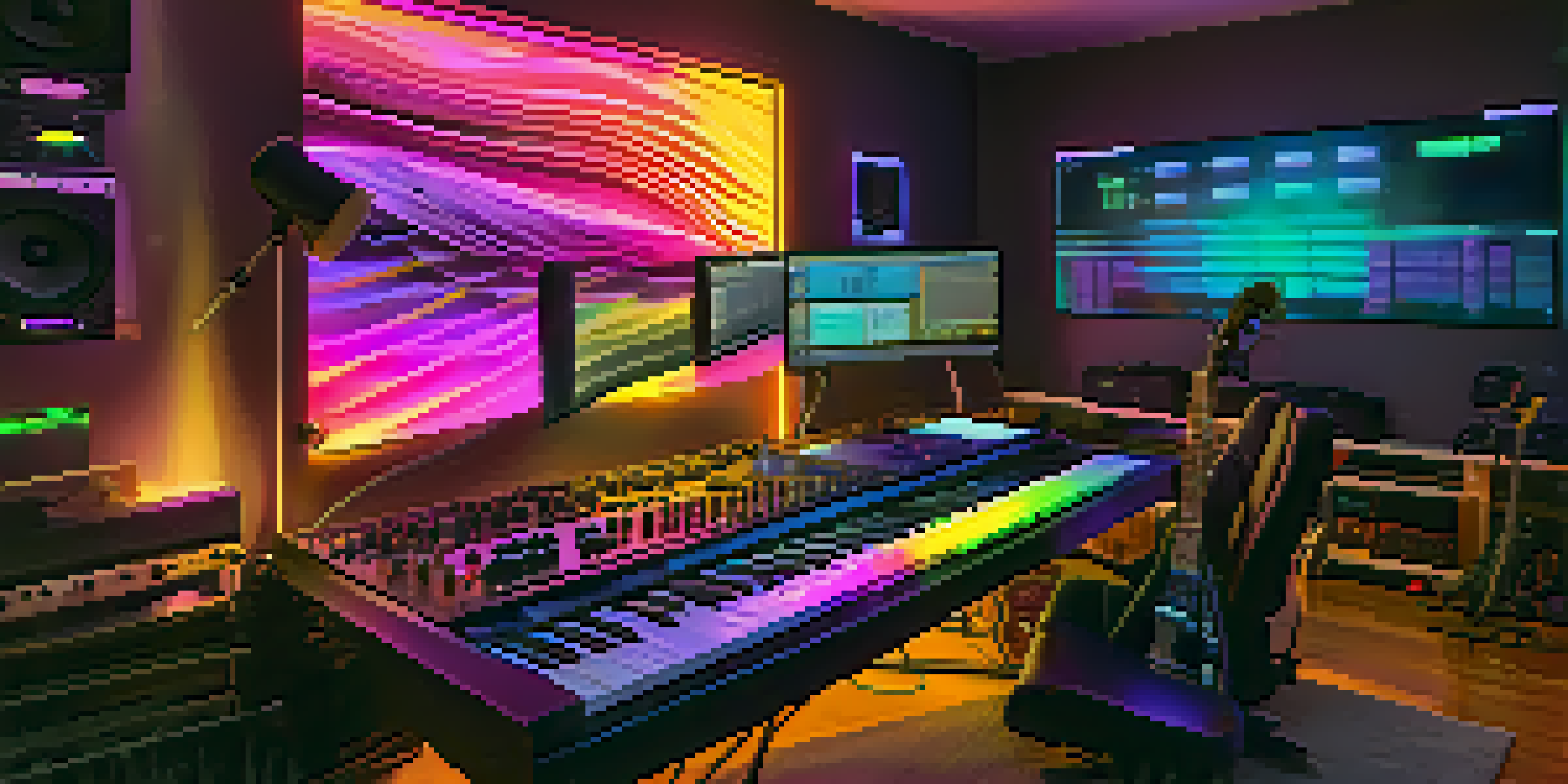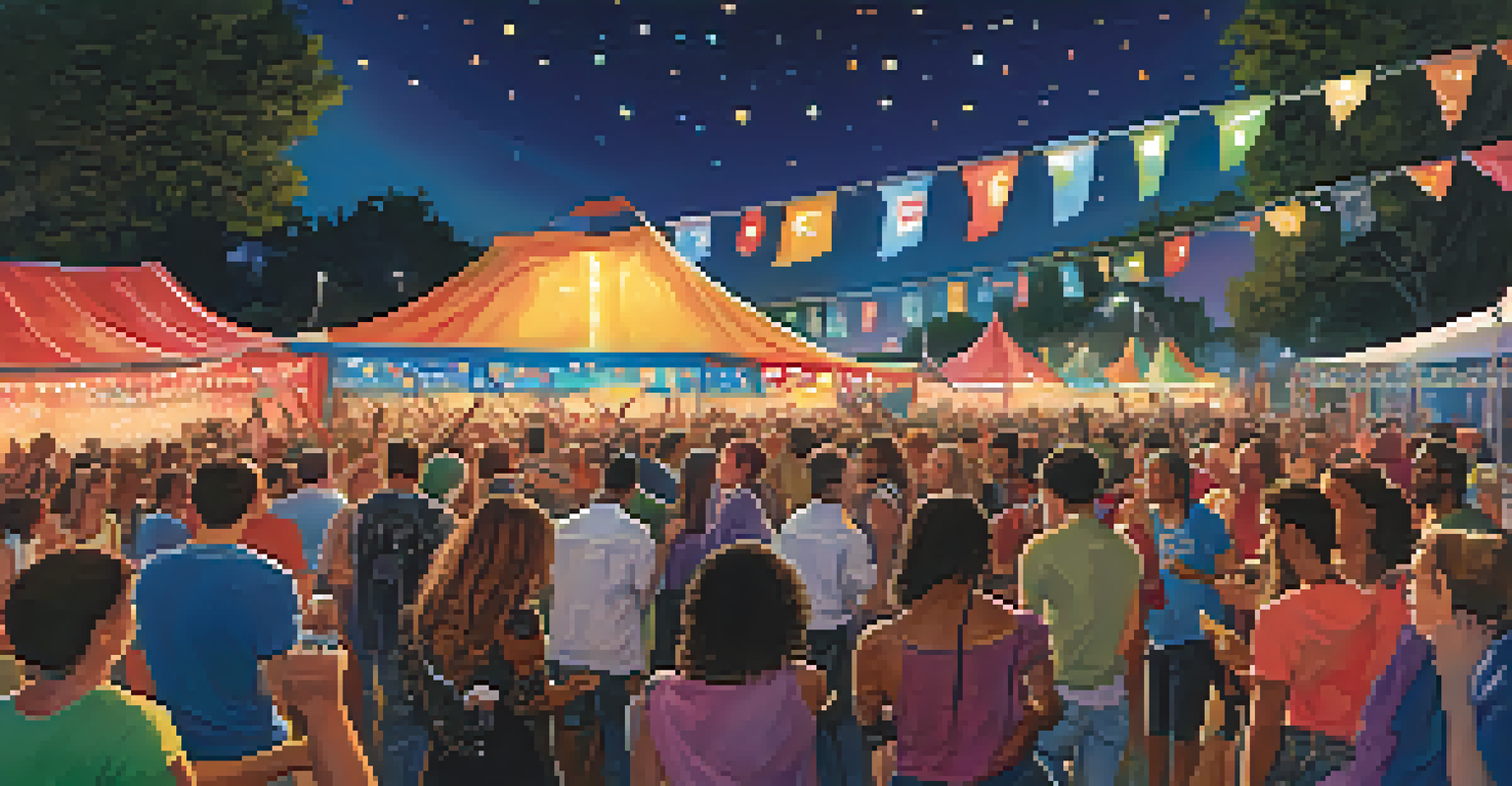The Role of Technology in Crossover Music Genres Today

Defining Crossover Music and Its Evolution
Crossover music blends elements from different genres, creating a unique sound that appeals to diverse audiences. Over the years, this genre has evolved, reflecting cultural shifts and technological advancements. From the fusion of rock and hip-hop to the mingling of country and pop, crossover music showcases the beauty of musical diversity.
Music is the universal language of mankind.
As artists experiment with various styles, they often rely on technology to produce innovative sounds. Digital audio workstations (DAWs) have transformed how musicians create and edit music, making it easier to mix genres. This accessibility has opened the doors for countless artists to explore crossover possibilities, regardless of their background.
Today, crossover music is not just a genre; it’s a dynamic movement that reflects the interconnectedness of global cultures. With the rise of streaming platforms, listeners can discover and support crossover artists, leading to a broader acceptance of genre-blending. As technology continues to evolve, so does the landscape of crossover music, inviting more experimentation and collaboration.
The Role of Digital Tools in Music Production
Digital tools are revolutionizing music production, enabling artists to experiment with sounds and styles without traditional constraints. Programs like Ableton Live and Logic Pro allow for seamless integration of various genres, fostering creativity. These tools empower musicians to manipulate sounds in ways that were once only possible in professional studios.

Moreover, the accessibility of these digital tools has democratized music production. Aspiring artists can now create high-quality tracks from their bedrooms, leading to an explosion of crossover music. With just a laptop and some software, anyone can explore the fusion of genres that speaks to them.
Crossover Music Redefines Genres
Crossover music blends various genres, fostering a unique sound that reflects cultural diversity and innovation.
This shift has not only changed how music is made but also how it is shared. Artists can collaborate online, drawing influences from one another regardless of geographical barriers. This interconnectedness enhances the crossover genre, allowing for a rich tapestry of sounds that reflects a global culture.
Streaming Services and Genre Blending
Streaming services like Spotify and Apple Music have had a profound impact on the music industry, especially in promoting crossover genres. These platforms use algorithms to suggest tracks based on listeners’ preferences, often introducing them to music from different genres. This exposure encourages fans to explore a wider range of sounds and styles.
The beauty of music is that it connects people, transcending boundaries and genres.
Curated playlists, such as 'Today's Top Hits' or 'Chill Vibes,' often feature crossover tracks, showcasing how different genres can coexist. This not only boosts the visibility of crossover artists but also encourages collaborations between genres. As listeners embrace this diversity, artists are inspired to create more fusion music.
Additionally, the global reach of streaming services allows artists to tap into new markets. A Latin pop song can become a hit in the U.S., leading to collaborations with hip-hop artists, for instance. This cross-pollination of genres becomes easier with technology, ultimately enriching the music landscape.
Social Media's Influence on Crossover Music
Social media platforms like TikTok and Instagram play a crucial role in the promotion and popularity of crossover music. Artists often use these platforms to showcase their unique sounds, reaching audiences directly. A catchy crossover track can go viral in a matter of days, leading to increased interest and collaboration opportunities.
Through short clips and engaging content, artists can experiment with their music and receive instant feedback from listeners. This real-time interaction encourages artists to push boundaries and blend genres. As a result, social media has become a powerful tool for discovering and promoting crossover talent.
Digital Tools Empower Musicians
The rise of digital production tools has democratized music creation, allowing aspiring artists to experiment with genre fusion from anywhere.
Moreover, fans can actively participate in the music creation process by sharing their own interpretations or remixes. This engagement fosters a sense of community among listeners and artists alike, creating a space where genre boundaries are blurred. It’s a vibrant example of how technology enhances the crossover genre experience.
Collaborations: Technology Connecting Artists
Technology has made it easier than ever for artists from different genres to collaborate. With the advent of online collaboration tools, musicians can work together on projects without being in the same room. This has given rise to exciting partnerships that might not have occurred otherwise.
For example, a country singer might team up with a hip-hop artist to create a track that incorporates elements of both genres. These collaborations often lead to fresh sounds and innovative music that resonates with a wide audience. Technology facilitates this process, allowing for easy communication and sharing of ideas.
Additionally, virtual reality (VR) and augmented reality (AR) are beginning to play a role in music collaboration. Artists can create immersive experiences that blend visuals and sounds, further enhancing the crossover genre. As technology evolves, so too will the possibilities for artists to connect and create.
The Impact of AI on Music Creation
Artificial Intelligence (AI) is transforming the music industry, and its impact on crossover genres cannot be overlooked. AI tools can analyze vast amounts of music data to identify patterns, helping artists create new tracks that blend styles. This technology opens up exciting opportunities for experimentation and innovation.
For instance, AI can suggest chord progressions or melodies that merge different genres, acting as a collaborator for artists. This can lead to unexpected and refreshing sounds that challenge traditional norms. With AI, artists can push the limits of what’s possible and explore unique combinations.
Streaming Fuels Genre Exploration
Streaming services enhance the visibility of crossover music, encouraging listeners to explore diverse sounds and facilitating cross-genre collaborations.
However, the rise of AI also raises questions about creativity and authenticity. While AI can enhance the music-making process, there’s a fine line between inspiration and imitation. As artists navigate this new landscape, they must find a balance that respects their artistic vision while embracing technological advancements.
Future Trends in Crossover Music and Technology
As technology continues to advance, the future of crossover music looks promising and exciting. We can expect to see even more genre-blending, as artists are inspired by a globalized music scene. The potential for innovation will only grow with emerging technologies like blockchain and advanced sound engineering tools.
Additionally, the accessibility of music production tools will continue to empower aspiring artists. With more individuals able to create and share their music, we can anticipate a surge of diverse sounds and collaborations. This democratization of music creation will likely lead to an even richer crossover genre landscape.

Ultimately, the intersection of technology and music is an ever-evolving journey. As artists, listeners, and technology continue to influence one another, the possibilities for crossover music are limitless. The future is bright, and we can’t wait to see what innovative sounds emerge next.